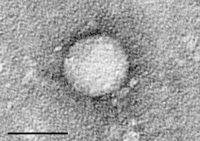
Photo from wikipedia
Hepatitis C virus (HCV) core antigen (HCVcAg) assay is an alternative for diagnosing HCV infection in a single step. This meta‐analysis aimed to evaluate the Abbott ARCHITECT HCV Ag assay's… Click to show full abstract
Hepatitis C virus (HCV) core antigen (HCVcAg) assay is an alternative for diagnosing HCV infection in a single step. This meta‐analysis aimed to evaluate the Abbott ARCHITECT HCV Ag assay's diagnostic performance (validity and utility) for diagnosing active hepatitis C. PubMed, EMBASE, Scopus, Web of Science, and Cochrane Library were searched until 10 January 2023. The protocol was registered at the prospective international register of systematic reviews (PROSPERO: CRD42022337191). Abbott ARCHITECT HCV Ag assay was the test for evaluation, and nucleic acid amplification tests with a cut‐off ≤50 IU/mL were the gold standard. Statistical analysis was performed using STATA with the MIDAS module and random‐effects models. The bivariate analysis was conducted on 46 studies (18,116 samples). The pooled sensitivity was 0.96 (95% CI = 0.94–0.97), specificity 0.99 (95% CI = 0.99–1.00), positive likelihood ratio 141.81 (95% CI = 72.39–277.79), and negative likelihood ratio 0.04 (95% CI = 0.03–0.06). The area under the summary receiver operating characteristic curve was 1.00 (95% CI = 0.34–1.00). For active hepatitis C prevalence values of 0.1%–15%, the probability that a positive test was a true positive was 12%–96%, respectively, indicating that a confirmatory test should be necessary, particularly with a prevalence ≤5%. However, the probability that a negative test was a false negative was close to zero, indicating the absence of HCV infection. The validity (accuracy) of the Abbott ARCHITECT HCV Ag assay for screening active HCV infection in serum/plasma samples was excellent. Although the HCVcAg assay showed limited diagnostic utility in low prevalence settings (≤1%), it might help diagnose hepatitis C in high prevalence scenarios (≥5%).
Journal Title: Reviews in Medical Virology
Year Published: 2023
Link to full text (if available)
Share on Social Media: Sign Up to like & get
recommendations!